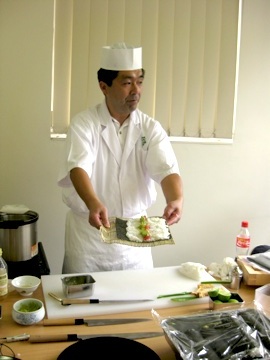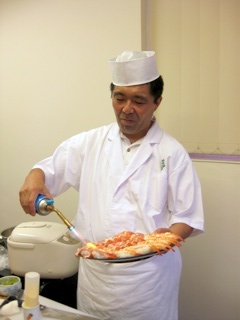“Mr. Taka’s Sushi Lesson and Tasting Party” was held on Friday 5th March at 6 pm and was sponsored by Go Go Melbourne.
Many participants gathered to attend this exciting event in spite of its short period of advertising.
Apart from Japanese participants there were also some Australians.
Mr. Taka looked so cool in his Japanese cooking coat and that style was what we considered “a true sushi chef”
He brought vinegared rice for us that he had prepared in advance because it usually takes about three hours to make it.

First, he showed us how to make “norimaki”, or sushi rolls.
He said that rice should be put in the centre of a sheet of “nori”, or dried seaweed, and spread in four directions.
At this point, you need to spread the rice softly to make good sushi rolls.
The rice in hand-made sushi rolls is not squashed and it looks as if the rice grains are “standing” in the rolls.
On the other hand, machine-made rolls taste different from hand-made ones because the rice grains are squashed as if they are “lying down”
Too much rice on the seaweed leads to difficulty in rolling.


This is what sushi rolls should look like Sushi rolls with tuna & avocado are the perfect colour match
Next lesson is how to make “nigirizushi”, or hand-shaped sushi.
You need about 15g of vinegared rice to make one rice ball.
So, you can make eight rice balls from one bowl of rice.
Some people avoid eating sushi saying they are on a diet, but the truth is that sushi doesn’t make you gain weight.

As may be expected of a sushi chef, he has a range of knives from a fish-slicer to a big knife.
When the sushi chef cuts a fillet of a fish into slices, by moving the knife, with its blade slightly tilted, through the fillet towards him, and then lifting its handle with the point of its edge touching the bottom part of the fillet.

Mr. Taka reminds me of an old Japanese song about legendary Japanese chef who decided to set out for a journey to sharpen his skills.
The song starts with the line below:
“The only thing I need is ….this knife, wrapped in bleached cotton cloth…”
The participants in this lesson were listening intently to Mr. Taka, and from time to time said “Oh I see…”
Mr. Taka told us secrets which most chefs wouldn’t reveal.
He said chefs often wipe off the cutting board with cold towel to keep their hands cold, otherwise the rice sticks to their hands.
(This is the way they keep their hands cold without customers realizing it.)
And what’s more, not only does “wasabi” give sushi a good flavour but it also serves to paste the sliced fish to the rice ball.

The participants who are trying to make “nigirizushi.”
Looking at Mr. Taka doing his job, you may think it is easy to make “nigirizushi”, but actually it is not as simple as it looks.
Surely lots of practice is needed.
But Mr. Taka said many of those who learned how to make sushi from him are still enjoying making sushi at home.
So, all participants were eager to take this chance to learn how to make sushi.
Mr. Taka always tries to use seafood and vegetables as sushi ingredients which we can easily buy.
Normally he makes sushi with ingredients that he gets at Japanese groceries or local supermarkets in Melbourne.
He sprinkles a bit of salt and a few drops of lime juice on frozen scallops and squid to rid them of their smell.
Actually one could enjoy a good aftertaste of fresh lime.


Finally, it’s time to eat.
The participants around the table seemed unable to stop grabbing one sushi after another.
No sooner had Mr. Taka made sushi than they they disappeared into the participants mouths.
And they were really delicious.
It is certainly the best vinegared rice in Australia.
Mr. Taka said sushi connoisseurs eat sushi to taste the vinegared rice.
Good vinegared rice makes sushi taste good, even when the other ingredients are not so good.
We enjoyed sushi with vinegared mackerel, prawns, scallops, tuna, salmon, squid, fresh mackerel, and suchlike.
“Oshizushi”, which is lightly pressed piece of sushi topped with vinegared mackerel is perfectly vinegared, and pleases our Japanese taste.
“Oshizushi” also keeps longer than any other kind of sushi.

When Mr. Taka made sushi with prawns, he put mayonnaise on them and then browns the surface, using a kitchen torch.
All you have to do is to brown the mayonnaise, not the prawns.
Probably because it was dinner time, we got so absorbed in eating sushi.
Beer and wine were served and we were a little drunk.
Moreover, we were given soy sauce and a Japanese traditional sweet called “dorayaki” as a present.
Well, we really enjoyed this event and we ate to our hearts’ content.
We enjoyed the beer and wine, as well!
It’s a good deal which you could never find anywhere else.
Let’s look forward to the next lesson.



